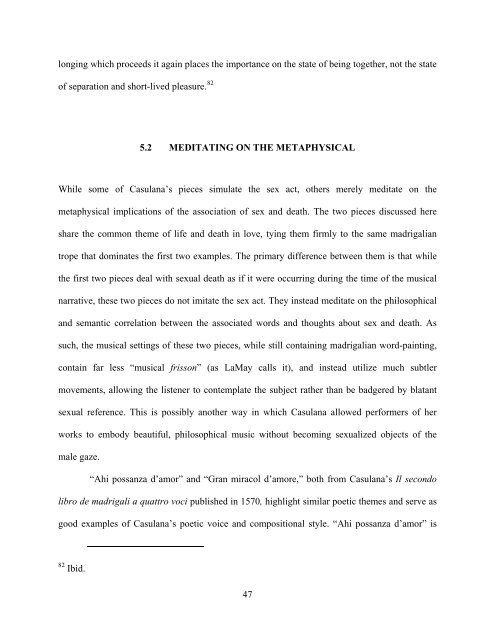Download - D-Scholarship@Pitt - University of Pittsburgh
Download - D-Scholarship@Pitt - University of Pittsburgh
Download - D-Scholarship@Pitt - University of Pittsburgh
You also want an ePaper? Increase the reach of your titles
YUMPU automatically turns print PDFs into web optimized ePapers that Google loves.
longing which proceeds it again places the importance on the state <strong>of</strong> being together, not the state<br />
<strong>of</strong> separation and short-lived pleasure. 82<br />
5.2 MEDITATING ON THE METAPHYSICAL<br />
While some <strong>of</strong> Casulana’s pieces simulate the sex act, others merely meditate on the<br />
metaphysical implications <strong>of</strong> the association <strong>of</strong> sex and death. The two pieces discussed here<br />
share the common theme <strong>of</strong> life and death in love, tying them firmly to the same madrigalian<br />
trope that dominates the first two examples. The primary difference between them is that while<br />
the first two pieces deal with sexual death as if it were occurring during the time <strong>of</strong> the musical<br />
narrative, these two pieces do not imitate the sex act. They instead meditate on the philosophical<br />
and semantic correlation between the associated words and thoughts about sex and death. As<br />
such, the musical settings <strong>of</strong> these two pieces, while still containing madrigalian word-painting,<br />
contain far less “musical frisson” (as LaMay calls it), and instead utilize much subtler<br />
movements, allowing the listener to contemplate the subject rather than be badgered by blatant<br />
sexual reference. This is possibly another way in which Casulana allowed performers <strong>of</strong> her<br />
works to embody beautiful, philosophical music without becoming sexualized objects <strong>of</strong> the<br />
male gaze.<br />
“Ahi possanza d’amor” and “Gran miracol d’amore,” both from Casulana’s Il secondo<br />
libro de madrigali a quattro voci published in 1570, highlight similar poetic themes and serve as<br />
good examples <strong>of</strong> Casulana’s poetic voice and compositional style. “Ahi possanza d’amor” is<br />
82 Ibid.<br />
47















